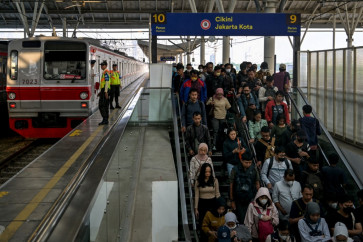Popular Reads
Top Results
Can't find what you're looking for?
View all search resultsPopular Reads
Top Results
Can't find what you're looking for?
View all search resultsFashion Flair: Reinventing Indonesian fabrics for today
Rinda SalmunWords Tertiani ZB Simanjuntak Photos Jerry AdigunaTen young designers flooded the catwalk recently with their interpretations of Indonesian traditional kain (fabric) at FIMELAfest 2016
Change text size
Gift Premium Articles
to Anyone
Rinda Salmun
Words Tertiani ZB Simanjuntak Photos Jerry Adiguna
Ten young designers flooded the catwalk recently with their interpretations of Indonesian traditional kain (fabric) at FIMELAfest 2016. From the Javanese commoner’s striped lurik to the extravagant beauty of songket from West and South Sumatra, Indonesian cloth was never before presented this way.
Other than batik, which used cotton or silk materials, the traditional fabrics were dominated by examples of handwoven cloth that are rarely seen in modest wear. The designers gave the traditional fabrics a modern and edgy cut that would be fit for fashionable career women of all ages.
The show, titled Cita Nusa Kirana and sponsored by cosmetics manufacturer Pond’s, opened the Festival Fashion Kain Indonesia (Indonesian Fabric Fashion Festival). It was the highlight of the event that also featured shows by top designers Didiet Maulana and Barli Asmara.
The fifth installment of FIMELAfest 2016 by the Jakarta-based online fashion and lifestyle media was held from Aug. 17-21 in Gandaria City, South Jakarta. Themed Wajah Baru Indonesia (Indonesian New Faces), the event introduced young creators and their inspiring works, with awards presented to designers Monique Soeriaatmadja, Dea Valencia and Jenahara.
“These young designers have shown their dedication to traditional fabrics and fashion,” said FIMELA publishing director Dian M. Muljadi.
Stella Rissa
Mesmerized by the heritage elements and the intricate details of traditional fabrics, she picked kain tenun bulu from Garut – handwoven silk with feathery motifs from the region in West Java. Whether in black, silver or white and blue, Stella tapped into the motifs to seamlessly become part of the design itself. One example is the full skirt in which she cut along the wavy zigzag pattern on its bottom edge.
Nina Nikicio
“Indonesian fashion has not been exposed the way it should be on international stages because many think that it is not modern enough,” she said about the project. The designer made a stunning transformation of lurik into loose long coats, two-piece and wide leg pants that could fittingly take to the runways of New York. To uphold her signature design elements in her first time ever working with traditional fabrics, she used only black and white lurik.
Jenahara
The rising designer in the world of Muslim fashion used woven cloth produced by Dewandaru that came in pink and white stripes to dark blue with white motifs, as well as multi-dyed fabric in the energetic color palette of maroon and gray. The collection consists of jackets, pants, tunic shirts and two-pieces that are a perfect fit to be worn for a day at work followed by an event in the evening.
Monique Soeriaatmadja
Monique presented seven items from her SOE line’s Fall/Winter 2016 collection that were modified for the project. Using the woven cloth of Pekalongan, Central Java, an area that is traditionally known for its batik, she created simple yet daring designs. Dominated by khaki and red, the capsule collection consists of A-line dresses, asymetrical frilled tops and two-piece creations adorned with tassels.
Dea Valencia
The 22-year-old brought a collection of all pink knee-length dresses she created from old or defective batik. Under the label Batik Kultur that she founded by selling her creations online worldwide through Facebook, and later Instagram, Dea has the ability to “save” the motifs by creating designs that let them stand out. Asymetrical cuts and the use of sequins enhance the soft colors of the material.
Restu Anggraini
The palette of blue and white was never such a sure choice to go to work before this. Restu designed Muslim wear on natural dyed indigo batik produced by Galeri Batik Jawa. She combined the pale blue batik with outerwear of stronger colors or a loose vest of white-and-blue striped woven cloth.
Miranda Mazuki
The designer’s choice was the songket woven cloth of Padang, West Sumatra, produced by Cita Tenun Indonesia. Based on her dream of making traditional fabrics more accessible to those who never owned them, the collection offered a modern, but modest way to wear it. She played with volume and draping in her signature style that succeeded in making the pastel-colored songket shine through.
Rinda Salmun
Her collection is a collage of colors and textures on structured silhouettes in jackets and cutout dresses. She brilliantly combined Padang songket and tenun bulu Garut produced by Batik Concept in designs that were thoroughly modern, yet maintained the beauty of the textures and motifs of the traditional fabrics.
Mel Ahyar
The “Lungsin” collection of Mel Ahyar Couture pays homage to the designer’s heritage of Palembang, South Sumatra. She reconstructed the extravagant songket into modern wear that would make an attention-getting entrance at a gala. The heavy textures of woven cloth were contrasted with flimsy fabric, adorned with manually sewn sequins.
Gloria Agatha
A collection in bright colors of blue, orange, red and yellow that is suitable for a fun summer holiday. Using the woven cloth of the Badui tribe from West Java produced by Cita Tenun Indonesia, Gloria played with the colors and geometrical motifs. She also designed matching bags to go with the outfits.










